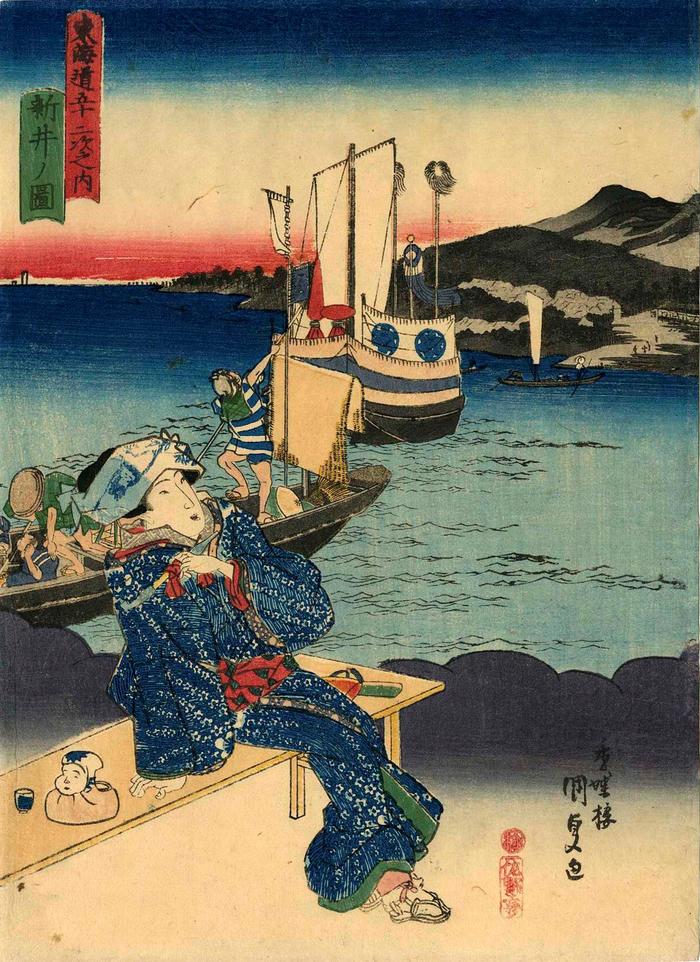Utagawa Kunisada (歌川国貞) / Toyokuni III (三代豊国) (artist 1786 – 01/12/1865)
View of Arai (Arai no zu: 新井ノ図) from the chuban series Fifty-three Stations of the Tōkaidō Road (Tōkaidō gojūsan tsugi no uchi: 東海道五十三次之内)
ca 1838
7 in x 9.75 in (Overall dimensions) Japanese woodblock print
Signed: Kōchōrō Kunisada ga (香蝶楼国貞画)
Publisher: Sanoya Kihei
Censor's seal: kiwame
Museum of Fine Arts, Boston
National Diet Library
British Museum - Hiroshige's 'Arai watashi-bune no zu' version
Museum für angewandte Kunst, Vienna
Minneapolis Institute of Art
Ishikawa Prefectural Museum of Art - they date their copy to 1836
Bryn Mawr
Honolulu Museum of Art
The Spencer Museum of Art
Google maps - the Arai district
Sidney and Lois Eskenazi Museum of Art, the University of Indiana "Separated from Maisaka by 2 miles of ocean and Lake Hamana, Arai was only approachable by ferry. The station was also famous for the inspection barrier (sekisho), which performed as severe a check of travelers as that of the Hakone barrier... Here the shogun's official particularly watch for the transport of guns, and also tried to apprehend members of daimyo families attempting to flee from Edo."
Quoted from: Hokusai and Hiroshige: Great Japanese Prints from the James A. Michener Collection, Honolulu Academy of Arts on page 195.
****
This is print number 32 in this series. The curatorial files for Museum für angewandte Kunst in Vienna say: "The first character in “Arai 新 井” was written here with the character for “new 新” instead of the one for “wild 荒”, as is otherwise found on woodcuts from Tōkaidō series. In the landscape representation, Kunisada sticks to the Hiroshige model again with a few changes. In the foreground a woman sitting on the bench of a tea house. In her hand she holds a pipe, around which she has tied a piece of cloth. Next to her on the bench is her tobacco pouch and the case for the pipe. On the other side is a ceramic vessel on which a face has been modeled. Next to it is a teacup."
Kunisada's chuban Bijin Tokaido (東海道美人) series was first published around 1833, after Hiroshige's famous series was underway but not yet complete.
****
In Tokaido Landscapes: The Path from Hiroshige to Contemporary Artists, 2011, #32, p. 44, speaking of the original Hiroshige print it says in a text by Sasaki Moritoshi: "The daimyo's boat, a deluxe vessel with curtains strung around it and lances with heads made of feathers, and another boat carrying lower-ranking samurai attendants, are crossing from Maisaka to Arai. The print is composed so that following the line of the gunwale of the attendants' boat leads the eye to the boat's destination - the Arai barrier station. The attendants' relaxed manner, particularly the humorous expression on the man stretching in a large yawn, serves to soften the tension of the impending inspection, which is rigorous at the Arai checkpoint."
The yawning fellow is not part of the Kunisada print design.
The elaborate boat is called a goza-bune (御座舟) or 'honorable seat boat' used by a daimyo. His men are in the smaller boat, a watari-bune (渡船), being ferried across behind it. On the deck of the jinmaku (陣幕) are two jinmaku or 'camp curtains' providing a degree of privacy and security to the daimyo. The outer one is a generalized one, but the inner one of blue on white is decorated with that lords personal crest.
****
In Hiroshige: l'art du voyage, Paris, 2012, p. 80 it says that many travelers when they got to Maisaka would shorten their trip by land by taking boats over to Arai. In order to board the boats they would have to show their travel permits.
****
Muneshige Narazaki in Masterworks of Ukiyo-e: Hiroshige, the 53 Stations of the Tōkaidō (p. 63) says that the tall lances are topped with fur. Above Sasaki Moritoshi says they were topped with feathers. We don't know which it is, but we will try to find out.
Narazaki also notes that the distance across the water from Arai to Maisaka was about two miles.
****
Illustrated in a small color reproduction in Kunisada's Tokaido: Riddles in Japanese Woodblock Prints by Andreas Marks, Hotei Publishing, 2013, page 70, T24-32.
Sanoya Kihei (佐野屋喜兵衛) (publisher)
landscape prints (fūkeiga 風景画) (genre)
